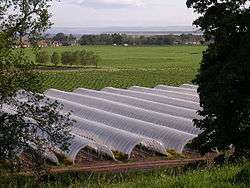Polytunnel

A polytunnel (also known as a polyhouse, hoop greenhouse or hoophouse, or high tunnel) is a tunnel made of polyethylene, usually semi-circular, square or elongated in shape. The interior heats up because incoming solar radiation from the sun warms plants, soil, and other things inside the building faster than heat can escape the structure. Air warmed by the heat from hot interior surfaces is retained in the building by the roof and wall. Temperature, humidity and ventilation can be controlled by equipment fixed in the polytunnel or by manual opening and closing of flaps. Polytunnels are mainly used in temperate regions in similar ways to glass greenhouses and row covers. Besides the passive solar heating that every polytunnel provides, every variation of auxiliary heating (from hothouse heating through minimal heating to unheated houses) is represented in current practice. The nesting of row covers and low tunnels inside high tunnels is also common.
Uses
Polytunnels can be used to provide a higher temperature and/or humidity than that which is available in the environment but can also protect crops from intense heat, bright sunlight, winds, hailstones, and cold waves. This allows fruits and vegetables to be grown at times usually considered off season; market gardeners commonly use polytunnels for season extension. Beyond season extension, polytunnels are also used to allow cold-hardy crops to overwinter in regions where their hardiness isn't quite strong enough for them to survive outdoors. Temperature increases of only 5° to 15° above outdoor ambient, coupled with protection from the drying effect of wind, are enough to let selected plant varieties grow slowly but healthily instead of dying. The effect is to simulate "moving the farm south by several hardiness zones", that is, to create a microclimate that simulates the temperatures of a location several hardiness zones south (and protects from wind as well).
Every factor influencing a crop can be controlled in a polytunnel. Polytunnels are often used in floriculture and plant nurseries, as the revenue value of the plants can justify the expense.
Temperate regions
Polytunnels are mainly used in temperate regions in similar ways to greenhouses and cloches (row covers). Modern designs allow sowing and harvesting machines to move inside the structures so as to automate production. Polytunnels have had a significant effect on the production of strawberries in the United Kingdom. Other soft fruits such as raspberries and blackberries are also cultivated in the same way.
Other regions

In a tropical climate, temperatures are prone to soar above all normal levels. In such cases, foggers/misters are used to reduce the temperature. This does not increase the humidity levels in the poly house as the evaporated droplets are almost immediately ventilated to open air.
High-tech poly houses even have space-heating systems as well as soil-heating systems to purify the soil of unwanted viruses, bacteria, and other organisms. The recent Indo-Israel collaboration at Gharunda, near Karnal is an excellent example of Polyhouse farming taking place in a developing country.
If developing countries were to develop a special incentive program solely for fruit-and-vegetable farmers, especially in demographically large nations like India, then the migration rate from rural to urban areas (as well as the loss of horticultural and fruit/vegetable farmers) to urban areas may be reduced. This brings a huge potential to improve the farming sector, which is key to long-term economic stability. The small polytunnels used by each farmer in each village promote the cultivation of vegetables both on-season and off-season, and would actually help to moderate the market rate for fruit and vegetables in long run, on a year-round basis, and would help to satisfy local market needs.
For example, in India, the inability to grow tomatoes generates price spikes during the monsoon season. This is seen as an ideal time to grow tomatoes in polytunnels, since they providing the ideal climate for the crop. In India, the Abhinav Farmers Club grows flowers and organic vegetables in polytunnels.[1]
Development
Hoophouses have existed at least since the 1940s, but they are much more commonly used with each passing decade, and their design continues to evolve. Because of the wide variety of constantly changing designs, in reality there is an entirely continuous spectrum from high tunnels through low tunnels to the simplest row covers, although they are often thought about as discrete steps. Major themes of continuing development are (1) achieving the same results with lighter construction and less cost and (2) making hoophouses easily movable. The advantages of mobile hoophouses include greater return on investment (with the same unit of investment getting greater use per year across different crops in different months) and more flexibility on crop rotation without ever having to bother to dig the soil out of a stationary house (or use soil steam sterilization) to cure greenhouse soil sickness.
A US Department of Agriculture program is helping farmers install polytunnels. The program was announced at the US White House garden in December, 2009.[2]
Farmers in Iraq are building these in increasing number and adding drip irrigation to grow tomatoes.[3]
References
- ↑ Bhattacharyya, Pramit (May 17, 2012). "Planting the seeds of prosperity". Livemint.com. HT Media. Retrieved November 23, 2012.
- ↑ Office of Communications: United States Department of Agriculture (USDA) (December 16, 2009). "USDA to launch high tunnel pilot study to increase availability of locally grown foods" (Press release). Washington, DC.
- ↑ Tharp, Mike (July 17, 2009). "Once world's bread basket, Iraq now a farming basket case". McClatchyDC. The McClatchy Company.
External links
- USDA promotes hoop houses at White House garden event intro on YouTube. December 11, 2009 by USDA's channel on YouTube.
- "Quick Garden Hoop" The Martha Stewart Show. February 18, 2010.
- Robinson Polytunnels's channel on YouTube - Polytunnel construction and information videos.
- Haygrove Polytunnels - Worldwide Polytunnel Supplier